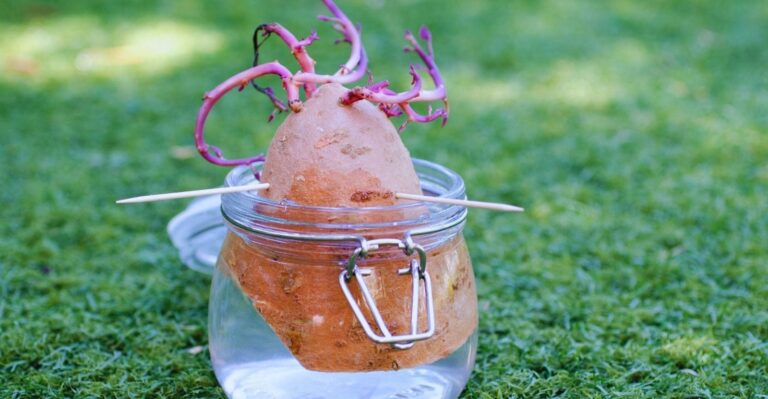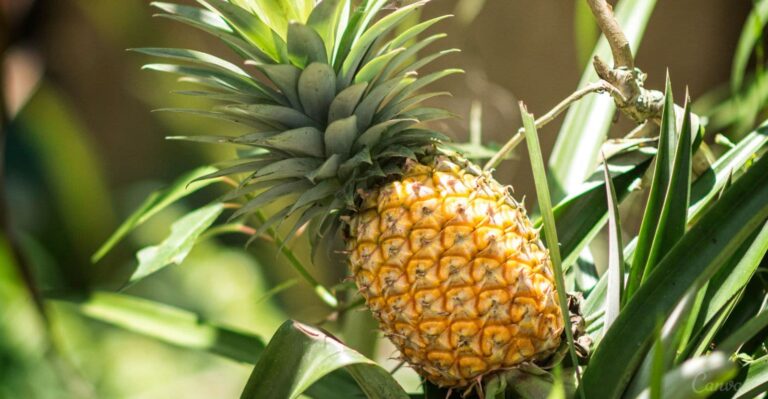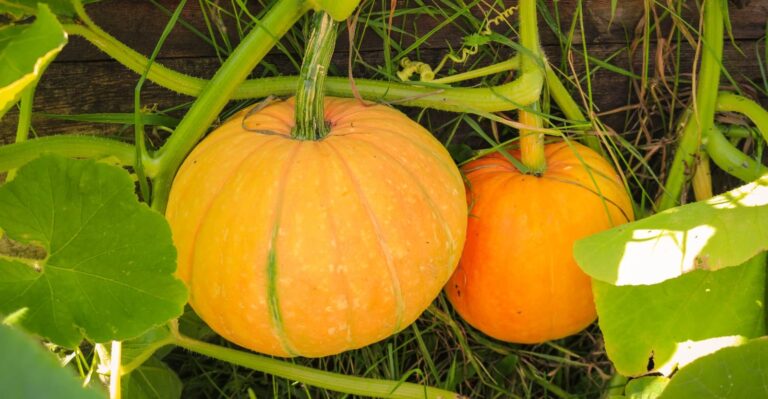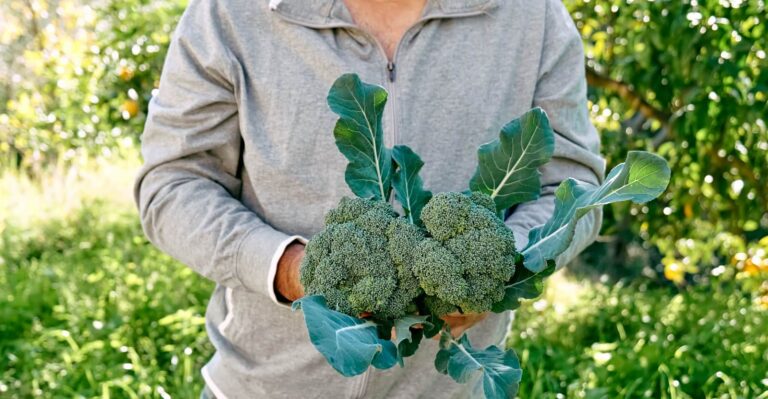Amazon has put together some great Home Gift Deals – save money and get your shopping done at the comfort of your home! Click here to see deals on Amazon
Are you looking to grow raspberries or maybe transplant raspberries but do not know from where to get started? This article will tell you all about growing, transplanting, pruning, and everything you need to know to get started.
But first, let’s understand why do you want to grow raspberries.
Benefits of Raspberries
Raspberries have several health benefits as it is a good source of vitamin A, folate, antioxidants, and minerals. It is not only the fruit that is full of nutrients, but the leaves of raspberries have various medicinal properties.
People in various countries do raspberries gardening to use raspberry leaves for different home remedies. The most common among them is to treat morning sickness, improve digestion, and rinse the throat.
The raspberry fruit is a good source of fiber, and it contains an abundant amount of vitamin C. The raspberry seeds contain vitamin E, which has several health benefits.
Several new research on raspberries suggests that it has cancer-preventing properties. The presence of ellagic acid in the red raspberries inhibits the growth of cancerous cells and promotes a healthy cell count.
Varieties of Raspberries
Raspberries are also known as brambles. The season and color of the fruit determine the raspberry classification. Primocane and Floricane are the two main ways raspberries are classified.
Primocane: The first-year raspberry plants are known as primocane. In this stage, the raspberry is at the growing mode, and the plant grows upwards with expansion from the plant crown.
Floricane: The second-year raspberry plant is called florican. In this year, the raspberry bears flowers and fruit.
There are three types of raspberries available:
- Summer-bearing red raspberries
- Everbearing red raspberries
- Black raspberries
The summer-bearing raspberries produce new canes from the ground in the summertime while it bears the fruit. The fruit comes from May to June on last year’s canes.
The everbearing raspberries are also known as fall-bearing raspberries. It produces flowers and the fruit on the mature tip of the current seasons’ growth starting in late summer to fall.
If you do not prune the cane in the fall, it will produce another smaller second crop on the lower half of the raspberry canes the following summer.
Black raspberries bear dark color fruit in June or July. It is produced on vines trained as shrubs. The black raspberries do not need a trellis.
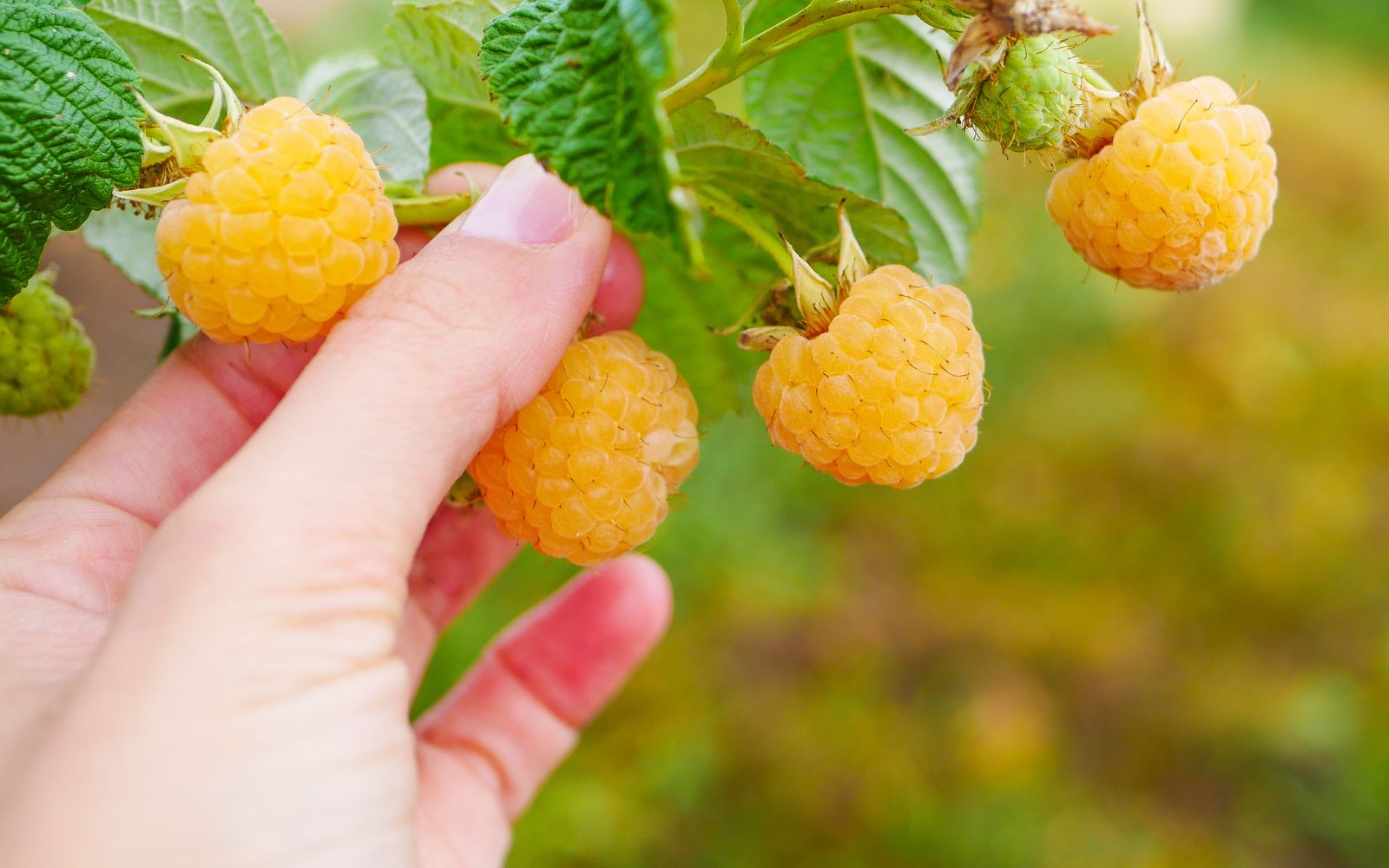
Summer Bearing Red Raspberry Bush
There are several varieties of raspberries grown in various parts of the world. It all depends on the climate and the soil conditions. “Willamette” and “Meeker” are the leading varieties in the Pacific Northwest but do not grow well in excessive heat.
The other kind such as “Canby” has thick, thorn-less canes and produces large light berries which are suitable for fresh consumption.
The other popular red raspberry bush varieties are Boyne, Killarney, Newburgh, Latham, Nova, and Prelude.
Everbearing Raspberry Bush
Some varieties of everbearing raspberry such as “Oregon 1030” are suitable to grow in hot weather. It is very heat and drought tolerant. The other types such as “Heritage” evergreen raspberries have vigorous vines. It produces dark red berries with a mild and dry flavor.
If you are looking for a small crop of large berries, then you can plant an “Indian summer” evergreen variety of raspberries. For yellow color with a mild sweet flavor, you can plant “Fallgold” which is a bushy plant with lower vigor.
The other popular varieties of ever-bearing raspberries are August Red, Autumn Bliss, Fall Red, and Polana.
Black Raspberry Bush
The black raspberries are the same as red raspberries. The main difference is that the fruit is black, firm, and has a more distinct flavor. The other key difference is that they are shrubs and do not sucker from roots.
The plant of black raspberries is formed when the arching cane tips root in the soil. “Munger” is a popular black raspberry variety that grows large, firm, shiny black fruit. Many people use it to eat fresh or freeze it for later use.
The other type called “Cumberland” bears large fruits but is less flavorful and contains lots of seed. The other popular varieties are Jewel, Early Sweet, and Black Hawk.
How To Grow Raspberries
There are two main ways you can grow raspberry plants. The most popular and easiest way is to grow it from the existing plant sucker by transplanting it, and the second way is to grow it from seed.
We will cover both ways so you can choose which works best for you.
Grow Raspberries From Seeds
Growing raspberries from seed is not a very popular way as it takes longer and needs more care than growing raspberries from the sucker.
The first step to growing raspberry bush from seed is to collect the fresh and ripe raspberry fruit in a mesh colander. Now mesh the fruit gently to turn the fruit like a jelly. Be careful not to mesh it hard otherwise that will damage the raspberry seeds.
Place the mesh under the running water while meshing. It will help to get rid of pulp and juice from the raspberry fruit. Once you remove the pulp, you will be left with a little brown raspberry seed in the mesh.
Wrap the raspberry seed in a paper towel and let it dry for 24 hours. Once the seeds have dried, prepare the 2-3-inch full nursery tray. Fill the nursery tray with a low amount of compost and put it in new potting soil.
Now grab each seed and gently press it in the soil with your thumb. Plant the next seed one inch apart in the nursery tray. Once the seed is planted, cover it with a thin layer of soil. Immediately water the soil to keep it moisturized.
Depending on the time when you are planting the seed, keep the nursery tray in the well-ventilated area. Maintain the moisture in the soil by regularly spraying it with water. Do not let the ground get dry as it causes the seed to become dormant again.
During the early spring, move the seed tray to the partial light area and keep watering the soil. Be extra careful not to let the soil dry at this stage. Germination of raspberry seed takes four to six weeks once placed in the sunlight area.
After the seed has grown one to two-inch in height, transplant the raspberry into the larger container. Provide some extra care to your fragile raspberry plant in the first year. Keep it under the low sunlight and water it regularly.
In winter, bring it inside and keep it in a well-ventilated area. Transplant it outdoor next spring, and you should have the new plant ready to grow further on its own.
Soil Requirement
You can keep raspberry growing for several years to come with proper care of the soil and plant. Raspberry plants like to grow in well-drained soil. The ideal pH for growing a raspberry plant is between 5.5 to 6.5. You may have to amend the land if your ground does not have a perfect growing pH level.
You can use soil pH testers to know the pH level of the soil. It is best to check the soil pH level around 6 months before you plant the raspberries. It gives the ground enough time to amend and be ready to nurture the new raspberry plant.
If your soil pH is below 5.5 pH, then it means the soil is too acidic for raspberries to grow. But don’t worry as you can quickly amend the ground to bring the required, ideal pH level.
To amend the acidic soil, add lime to the ground. If you do not want to use lime, then you can use organic compost in the sand and improve the aeration and drainage to maintain the right environment.
Apply the organic compost 2 to 3 cubic yards per square foot. It should be enough to lower the acidity of the soil level. Be careful with manure and organic fertilizer. Be sure that it does not contain any insects, weeds, or seeds in the compost.
Raspberry plants do not like much water. For planting locations with poor drainage, you can install drain tiles. These drain tiles should be at least 25 inches deep near the row. Another good alternative will be to plant raspberries in a raised garden bed.
Sun Requirement
Raspberry bush needs at least 6 to 8 hours of sunlight in a day. So, plant it in open areas where it can get enough sunlight. Do not plant it near the big trees.
The shades from the tree may prevent it from reaching adequate sunlight, which may hinder plant growth.

Planting Raspberries
For planting new raspberries, choose a location that is away from the existing raspberry plant. This will prevent the new plant from getting infected with the current disease.
Soak the root of a plant in half-strength vitamin B1 solution for 6 hours to nurture the root. Don’t over soak it; otherwise, the fragile raspberry roots will rot.
Here are a few essential things to keep in mind when planting raspberries:
Planting Red Raspberries
Red raspberries plants are cultivated in the hedgerow. In hedgerow planting, the shrub or bush is closely planted in a spaced single line. Keep each plant at least 2 to 3 feet apart in rows.
Planting Purple and Black Raspberries
These varieties of raspberries plants produce suckers from the base of the crow. It will not fill out a hedgerow as the red raspberry plants do.
Due to this reason, these are grown in the hill systems to get most fruit out of the individual plant. Keep these plants 4 feet apart in a row.
Best Time To Plant Raspberries
The best time to plant raspberries is in early spring when the plant is still dormant. If you have a dormant raspberry plant that is not ready to put in the ground, you can put it in the fridge to keep it dormant.
Before planting, make sure you prepare the soil by digging a hole and putting some organic compost or 4-20-20 fertilizer. This will provide the ideal condition for the new raspberry plant to propagate.
Spacing And Air Circulation Of The Raspberry Plant
Proper plant spacing and air circulation are essential for growing optimal raspberry fruit yield. Below is a recommended spacing for the raspberry plant.
| Raspberry Types | Training System | Plant Spacing | Row Spacing |
|---|---|---|---|
| Red & Yellow Raspberry | Hedgerow, Low Trellis | 2 Feet | 10 Feet |
| Black Raspberry | Hill, Low Trellis | 2.5 Feet | 10 Feet |
| Purple Raspberry | Hill, No Trellis | 3 Feet | 12 Feet |
Raspberry Pollination
Raspberry plants are self-fertile, which makes them easier to grow year after another. The raspberry flower contains a large number of pistils surrounded by many stamens. The pistils are the female part of the flower, and the stamens are the male part.
During the pollination, the pollen is transferred from the stamens to the pistils. Once fertilized, the pistils produce seed and a drupelet.
Honeybees are the primary source of pollination for brambles. It is recommended to maintain two hives of bees per acres for adequate pollination. Do not apply insecticides during the bloom period as it reduces the number of honeybees available to pollinate.
If you must apply insecticide to control other diseases, then choose pesticide, which is less toxic to bees. Apply insecticide in the late afternoon or at night when the bees are not visiting your garden.
Trellis For Raspberries
Raspberries need support to hold the canes upright. Trellis helps with planting, caring, and organizing raspberries. A good telling helps to:
- harvest Raspberries easily
- easy pesticide application
- improve light penetration to the plant
- prevent the fruit from touching the ground
There are several different types of trellis, while the most common are Hedgerow, V shape, and T shape trellis. A new kind of trellis called “shift trellis” is also used, which reduces the harvest cost while increasing the raspberry yield.
Trellis for Summer Bearing Red Raspberries
Summer-bearing red raspberry patch canes tend to spread outward. You will need to provide support to keep the canes upright.
Now depending on the number of raspberry plants, you can set up a wooden post that is 3 to 4 inches in diameter and around 6 feet above the ground.
To make training more manageable, you can run two sturdy wires at the top of the trellis on each side of the post. Place two wires about knee height size to lift it out over new primocane to pull them into a row and prevent any damage during the growing season.
It is better to use high tensile wire and add a wire-tightener in each of the top wires. Black and purple raspberries do not need a trellis.
T – Trellis for Raspberries

In a T-shape trellis, the posts are set up in a row with a 3.5-foot long cross arm. The cross arms are kept at 3.5 to 4.5 feet apart.
The posts are anchored deep in the ground of each side, and two strong ropes run through the trellis.
V – Trellis for Raspberries

V-trellis contains two posts that are set at a 30-degree angle to each other. The top distance is around 3.5 feet.
Hill System Trellis for Black and Purple Raspberries
As mentioned earlier, the black and purple raspberries do not need a trellis, but in a particular condition, the Hill system trellis is used. In this, two posts that are 4 feet apart are inserted into the ground.
A wire is run along these two posts to provide support. When the fruit gets ready, the branch of each plant is spread along with the cables.
In the end, you have to use trellis depending on the type of raspberry patch you are planting. Many people prefer to install three-wire trellis as it is easier to install and gets the job done.
In three-wire trellis, the single top wire is hung 4.5 feet above the ground, and the two detachable cables are placed 2.5 feet above the ground.
The detachable wires help to bring the newly grown canes into the row. These are then placed on a bend hook or nail attached to either side of the post.
Watering Raspberries

Raspberries need an average of one inch of water per week during the growing season. Make sure that you don’t overwater it as it will cause the root to rot.
You can use more water during the dry season or when the soil lacks the required moisture. Trickle or drip irrigation is the most preferred method to water raspberries as it provides the controlled watering of the plant.
How To Transplant Raspberries To Grow More Fruit
Raspberries are transplanted for several reasons. The most common goal for transplanting raspberries is to increase the size of the raspberry patch.
Another but a less common reason for transplanting raspberries is to divide the large and unmanaged raspberry plant.
But regardless of the reason, there are certain things that you need to keep in mind when transplanting raspberries.
Which Raspberry Plant To Transplant
You should start transplanting a raspberry plant, which is healthy-looking and is disease-free. If you are buying the raspberry plant from the local nursery or garden store such as Home Depot or Lowes, then pick the healthy-looking plant.
You can identify healthier raspberry plants by looking at the plant which has stable, vigorous canes and has green leaves.
Depending on the type of raspberry species you want to plant, it may grow straight upright, or have a spiraling or spreading growth habit. You need to know the growing pattern of the raspberry plant to decide the space you need for optimal growth.
Most of the raspberry plant grows 3 to 9 feet tall and spread almost the same distance. It is not advisable to transplant raspberries taken from the garden.
Often these plants may look healthy but are infected with a disease that causes them to slow down their growth and reduces the yield.
Buy the raspberry plants from a reputable plant nursery or garden store where you know that plants are grown in a controlled environment and are not infected with any disease.
Best Time To Transplant Raspberries
Raspberries grow very well from zone 3 to 11. These are healthy and hardy plants that can be moved from one location to another without much affecting the plant.
But for the optimal yield and growth, you should transplant it when it is in a dormant stage. Raspberries have a dormant stage in late fall to early spring.
You can still transplant it beyond the ideal transplanting period, but it may take a little longer to produce raspberry fruit.
If you are transplanting it in late fall, then do it as soon as the raspberry canes have finished the fruit season and have shed their leave. This is the time the plant starts to get ready to prepare for the winter season.
If you are transplanting it in early spring, then do it as soon as the frost has gone, and the ground has become workable. This is the period when the raspberry transition from dormant to active state.
Raspberries are spread by its root and are very aggressive in doing so. You should move it when the plant is still small and dormant to make it easier to successfully transplant.
How To Transplant Raspberries
Step 1: Pick a site where the plant can get full sun and does not get exposed to much water. Well-drained soil with the possibility of good air circulation is vital to get the new raspberry plant to hold its roots and grow strong.
Step 2: Dig around a 6-inch hole and add some compost couple of weeks before planting. This will prepare the ground and will optimize the soil condition to grow raspberries better. A widely used fertilization rule is to use 3.5 cubic feet of compost for a 100 square foot area.
Step 3: Maintain a reasonable distance among the plants to reduce the risk of spreading pests and diseases.
Step 4: Prepare the plant to transplant.
Transplanting raspberries from seed or garden plants
If you are transplanting raspberry bushes from a plant purchased from a garden and nursery, then dig a wide enough hole in the ground at the planting location. Make sure the areas are clear from weeds and pests to avoid the plant getting infected.
Remove the dirt around the hole and carefully place the plant along with its original soil in the hole. Cover the hole with the surrounding soil.
Water the plant immediately after filling the gap and if there are any air pockets, then fill it with more soil. Keep the soil moist and dry. It will ensure the speedy propagating of raspberries.
Transplanting raspberry from existing root
For transplanting raspberries from the existing root, cut the sucker plant using a shovel. But be careful not to cut the main root. Using pruning shears, carefully separate the young raspberry plant from the original plant. Make sure the root ball of the plant is intact.
Once the new plant is separated, plat it as soon as possible in the newly prepared hole. Fill the gap with water and put soil around it. The water will provide the necessary moisture for the new root to take hold of the ground.
Note:
When you are placing the new plant in the root, make sure you spread out the root before putting it in the hole. Do not wrap the roots around the hole and trim down any longer roots. If you are planting black and purple raspberries, then keep them at least 4 feet apart for optimal growth.
Step 5: Make sure you keep watering the new plant regularly as it will prevent the soil from drying out. Raspberry canes are very sensitive to drying out, you should keep them regularly watered and prevent them from extreme winds.
How To Care Raspberries
Fertilizer
Raspberries do not need much fertilizer. But for optimal growth, nitrogen-rich fertilizer can be provided to help boost raspberry fruit production.
During the first season of the raspberry plantation, add 50 pounds of nitrogen per acre of land. In the second year, you can add 50 to 150 pounds of nitrogen per acres from February to early March.
To have some estimation about the amount of nitrogen to use, look at the foliage color of raspberry. Apply less nitrogen on plants that looks healthy and the foliage is dark green.
But for the poor-quality soil where the leaf is light green and yellow, increases the nitrogen in the plant. Do not place fertilizer directly above the roots but spread it around the plant.
For a poorly growing fall crop of everbearing raspberries, use an additional 15 to 25 pounds of nitrogen. Once the bramble plant becomes dormant, apply the fall fertilizer.
To keep the raspberry plant, remain healthy, and bear the right amount of raspberry fruit, test the soil every three years. Based on the condition of soil and nutrient level, you can add phosphorous or potassium minerals to it.
Pruning
Raspberries need regular pruning as their crown and roots are perennial, but their cane is biennial. This means that raspberries have to be pruned annually as the canes which bear the fruit live for only two years.
Here is how to prune the raspberries.
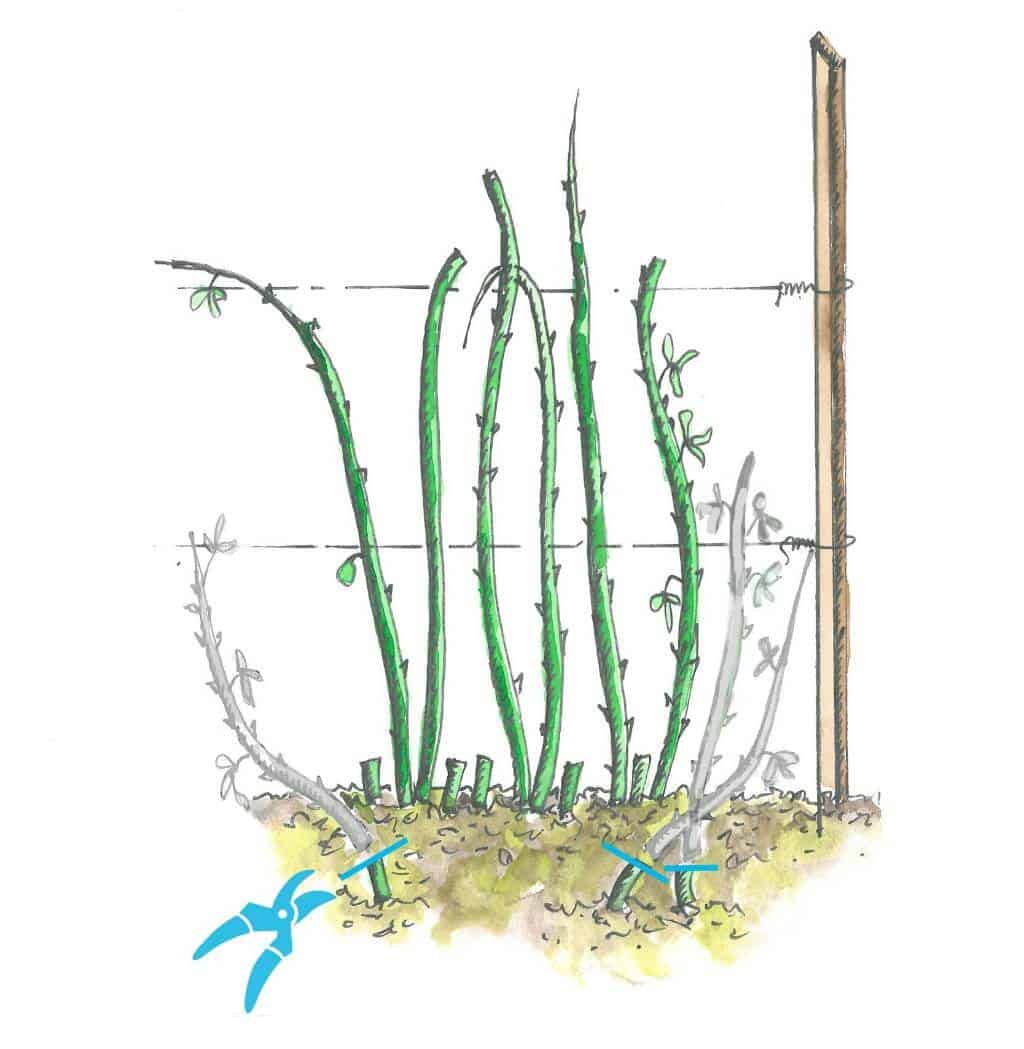

Pruning Red Raspberries
Red raspberries should be pruned after every harvest. This is done by removing all the canes that are fruited in the year. The pruning helps with the growth and air circulation to the canes. It strengthens the raspberry vines and gets them ready to bear fruit for the next year.
Red raspberries plant spread outward very quickly. Remove any new canes that grow beyond the 12 to 18-inch spread width. Don’t hesitate to prune any diseased or weak cane to support the healthy and stronger cane for the next year’s growing season.
When it comes to the spring and before raspberry vines bud, prune one more time to the remaining canes. Leave only four to five raspberries plants per foot of row.
You should have already built a trellis around the garden for support. Spread the remaining canes onto the wires of the trellis and tie them with twine or some soft material.
Pruning Everbearing Raspberries
The everbearing raspberries bear a late-season fruit on the first-year cane. Don’t prune it in the same manner as you would do for summer-bearing types. Everbearing raspberries bear two crops per season.

The first year everbearing raspberry cane – It bears fruit in fall and provides a single crop per season.
The second-year everbearing raspberry cane – It bears fruit in summer and fall and provides two crops per season.
In the first year of everbearing raspberry planting, you may be able to get only the fall crop by pruning the canes down in early spring. During the summer, cut down the new canes that develop outside of the 16-inch plant spread width.
If you have planted black and purple raspberries, then prune the top four inches of new canes in the early summer when the plant reached three feet in height.
Pruning in this manner stimulates the cane to form side branches or laterals which will bear the fruit next year.
Don’t leave any plant waste after pruning to prevent any spreading of the disease to the new growth of a plant.
Mulching
Mulching is necessary for weed control and to keep the soil moisture of the raspberry plant. You can mulch about 4 inches of organic materials such as rice hulls, wheat straw, or pine bark.
This also insulates the root from the deep winter frost, which is essential for it to propagate in the next spring.
You should replenish the much after each frost season to retain the efficiency of the mulch. It keeps the raspberry plant safe and ready to grow once the fall season is over.
Coverup Crops To Grow With Raspberries
Coverup crops help the plant grow naturally by providing the right environment and nutrients to the neighboring plants.
Following are the excellent coverup crop for raspberries.
- Leek
- Chamomile
- Turnip
- Garlic
- Tansy
Following crops should not be planted along with raspberries.
- Potato
- Strawberry
- Eggplant
- Pepper
Now let’s talk about common raspberries diseases and how to prevent them.
Disease and Preventions for Raspberries
Raspberries are a healthy plant, but several insects and pests can infect the plant which causes the reduced yield or at worse, the dead plant.
Here are some common diseases and prevention for raspberry plants.
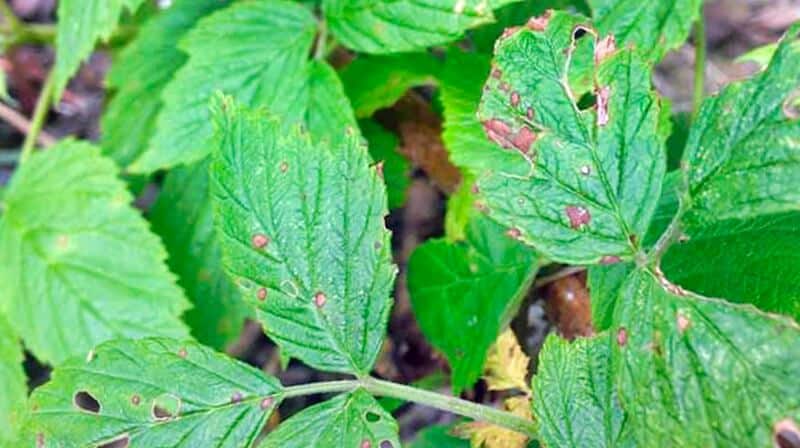
Anthracnose
Black and Purple raspberries are more affected by this disease. Once infected, the raspberry plant develops oval or circular grayish scaly spots on the cane and leaves.
This hinders the growth of the plant and causes the berries to dry up. You should cut the infected part of the plant to prevent the spreading of the disease. Then apply a delayed dormant spray when the leaves are still green to avoid future infection.
Luckily, red raspberries are less prone to get infected by anthracnose than black and purple raspberry.
Cane And Spur Blight
This disease attacks the cane of the raspberries. To prevent your raspberry patch, getting infected by this disease, you should remove and burn blighted and old canes after the harvest. There is no treatment once the plant gets infected.
The symptoms of cane blight are the development of the bleached area on the cane. The part of the cane above the canker dies or gets extremely weak and does not bear any fruit.
As a preventive measure, you can spray liquid lime sulfur spray in early spring, remove weed, and cut out any cane which appears to be infected.
Crown Gall
Crown Gall attacks the root and lower parts of the raspberry plant. It is more common on red raspberries but also affects the black and purple raspberries.
As usual, the treatment is to cut down the infected portion and pull out the plant from the root of the infection that has spread to the root.
As a preventive measure, you can treat the ground with Galltrol or Normac 84 before planting raspberries in Crown Gall-infested areas.
By treating it with the above solution makes the bacteria in the solution colonize the root system of the treated plant. It prevents the root from becoming infected with Crown Gall.
But it is a costly solution so only use it when you are dealing with a severe Crown Gall problem.
Orange Rust
Orange Rust is more common in the Kentucky area and is known to infect black and purple raspberries. But the good news is that it does not attack red raspberries. Once the plant is affected by Orange Rust, the leaves turn yellow and get twisted.
The lower side of the leaves then gets covered with bright orange pustules which becomes full of sores. The infected plant never gets recovered from the disease and does not bear any fruit.
For the best control, dig up the infested plant, including the root, and burn it. As a matter of precaution, also dig up any nearby plant to avoid future infections.
How to Harvest and Store Raspberries
Raspberries bear fruits over two weeks in the second year of their plantation. Depending on the type of raspberry tree, the raspberry fruit can grow in either summer or fall.
When the fruits become ripe, it changes their color, and you can easily pull them from the plant. Overripe raspberry will fall by a simple touch.
The unripe berry will be harder to remove from the plant and will be mainly in green color. You have to pick ripe berries every two days.
Picking raspberries are easy but storing raspberries are not as easy as it is perishable and has a short shelf life.
You can harvest and store it in the fridge for up to five days. Dry it up before you put it in the fridge and don’t wash it till you are ready to eat.
Here is an excellent video on successfully growing raspberries/blackberries.
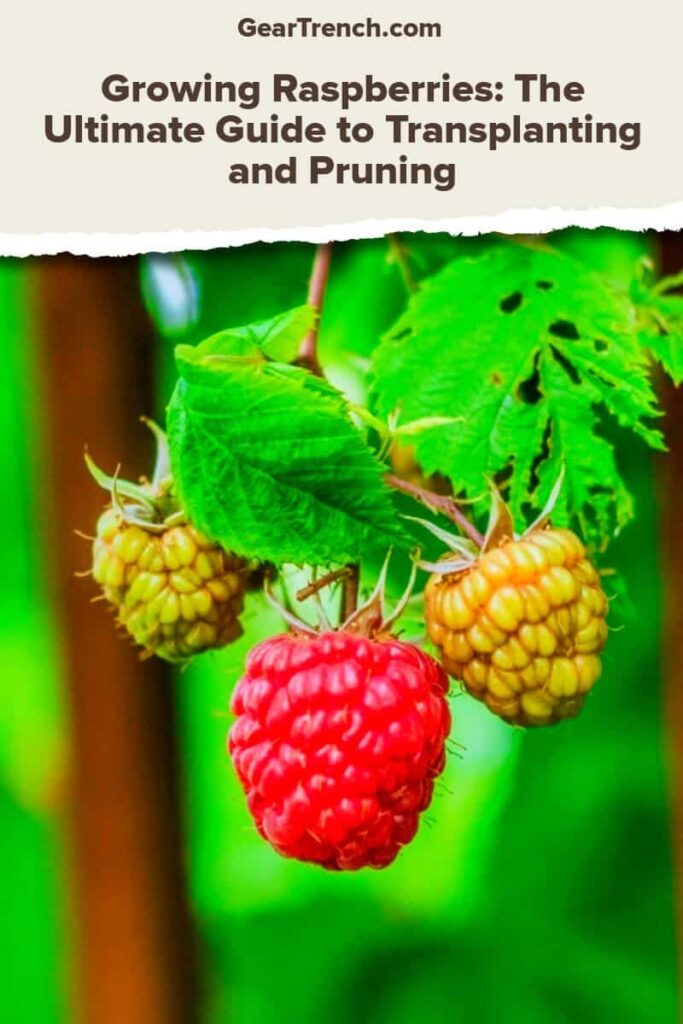
Don’t forget to share this post



